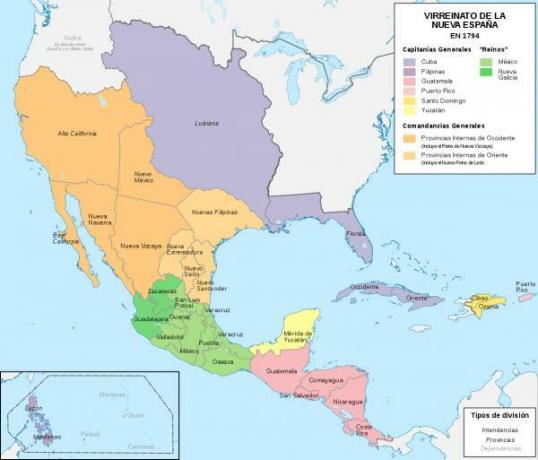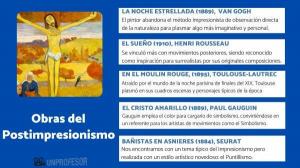Viceroyalty of New Spain

At its peak of splendor, the great spanish empire It had colonies in most of the planet, being especially relevant the so-called viceroyalties existing in the area of America. Among all these regions, one of those that came to have the most power was the one that is currently Mexico, and therefore in this lesson from a PROFESSOR we must offer a summary of the Viceroyalty of New Spain.
Index
- Map of the Viceroyalty of New Spain
- The conquest of Mexico and the birth of the viceroyalty
- Evolution of the Viceroyalty of New Spain
- Independence and end of the Viceroyalty
Map of the Viceroyalty of New Spain.
We begin this summary by offering you a map of the Viceroyalty of New Spain so that you can better visualize where this political entity was located.
The Viceroyalty was formed by present-day Mexico, for a large number of regions of the United States, parts of British Columbia of Canada, Guatemala, Belize, Costa Rica, El Salvador, Honduras, Nicaragua, Cuba, Dominican Republic, Puerto Rico, Trinidad and Tobago, Philippines and Taiwan

The conquest of Mexico and the birth of the viceroyalty.
Behind the arrival of Europeans to America in 1492A process of expansion began throughout all those unknown lands, conquering all the regions for the Spanish and ending all those peoples that opposed the Spanish advance.
Although some Spaniards had already reached theMayan zone, being examples Francisco Hernández de Córdoba or Juan de Grijalva, neither of them achieved great advances in the conquest of the region, although they did manage to discover large cities and transfer the information to the Peninsula.
In 1519, Hernan Cortes he received the orders to go to the territories discovered in the Mexican zone and to conquer it for the Spanish. Cortés defeated the indigenous people in Tabasco to form the first city of New Spain and a little later he conquered other cities in Veracruz, being the places where he received his translator Malintzin who would be key to taking over the Aztec regions.
The arrival of Hernán Cortés in Tenochtitlan
November 8, 1519 Cortés arrived at the capital of the Aztecs, Tenochtitlan, being the key moment for the formation of New Spain. The Mexica thought that Cortés was the one sent by an ancient prophecy that said that the end of the empire would be brought by a white person, being the reason why the leader of the region, Moctezuma, welcomed the Spanish people. Cortés and his men captured Moctezuma, but the Aztec people took up arms against the Spaniards and after many casualties the Spaniards left the city defeated in the call Tragic Night.
Thanks to his translator, Cortés had managed to connect with many peoples in the area, which hated the Aztecs for their conquests, and it was because of this that he got them all to join the Spaniards in their fight against the Aztecs. After months of fighting, the Spanish managed to defeat the Aztecs.
In 1520 Cortés sent a letter to King Carlos V asking him to call the newly conquered region New Spain, since he considered it to be a region very similar to the peninsular nation. Cortés destroyed the city of Tenochtitlan and built on its ruins the new Mexico City, capital of New Spain.
Evolution of the Viceroyalty of New Spain.
After years of little evolution in the Viceroyalty of New Spain, the arrival of the seventeenth century it was going to change many of the elements of the American region. While in Europe the Spanish monarchy entered a serious crisis due to the continuous struggles with other nations, and even the appearance of wars of succession, the viceroys of New Spain were found at the peak of his power.
At this stage, the region was marked by great periods of peace, only stopped by indigenous revolts or Dutch attacks, by large trade agreements with distant countries such as Japan or China, and by powerful viceroys who enrich themselves while inequalities grew in the region. region.
The change of the monarchy in Spain, from the Austrian to the Bourbon dynasty, caused New Spain to undergo great changes. The Bourbon reforms sought to change many of the elements of Spain, also affecting the administration of New Spain. The Bourbons changed the system of governors, sought to have more power from afar and take advantage of the resources of New Spain, provoking great riots in the region.
From New Spain the management of the monarchs was increasingly seen worse and in this situation of tension took place the War of Independence in Spain, being the nation taken by Napoleon's troops. It was at this strange stage that the road to the end of the Viceroyalty began.
Independence and end of the Viceroyalty.
To finish this summary of the Viceroyalty of New Spain, we must talk about the independence in the region and the end of the Viceroyalty, in order to understand the end of this region.
After the loss of power of the Spanish generated by the conquest of Napoleon, the Mexican patriots began to move in order to seek independence and end New Spain and generate a new state from its ashes.
The war was officially started on September 16, 1810 with the so-called Pain scream, when Miguel Hidalgo y Costilla, along with his men, rang the bells of the parish of Dolores to call to arms all those who wanted independence. The beginning of the war was a consequence of the Conspiracy of Querétaro, a movement that sought to reunite weapons to confront the Spanish authorities, but that upon being discovered by the Spaniards caused the Grito de Pains
After this, a movement began that would end with the Mexico's independence and the end of the Viceroyalty of New Spain as it was known.

If you want to read more articles similar to Viceroyalty of New Spain: summary, we recommend that you enter our category of Story.



